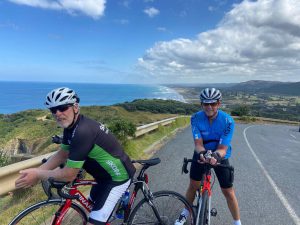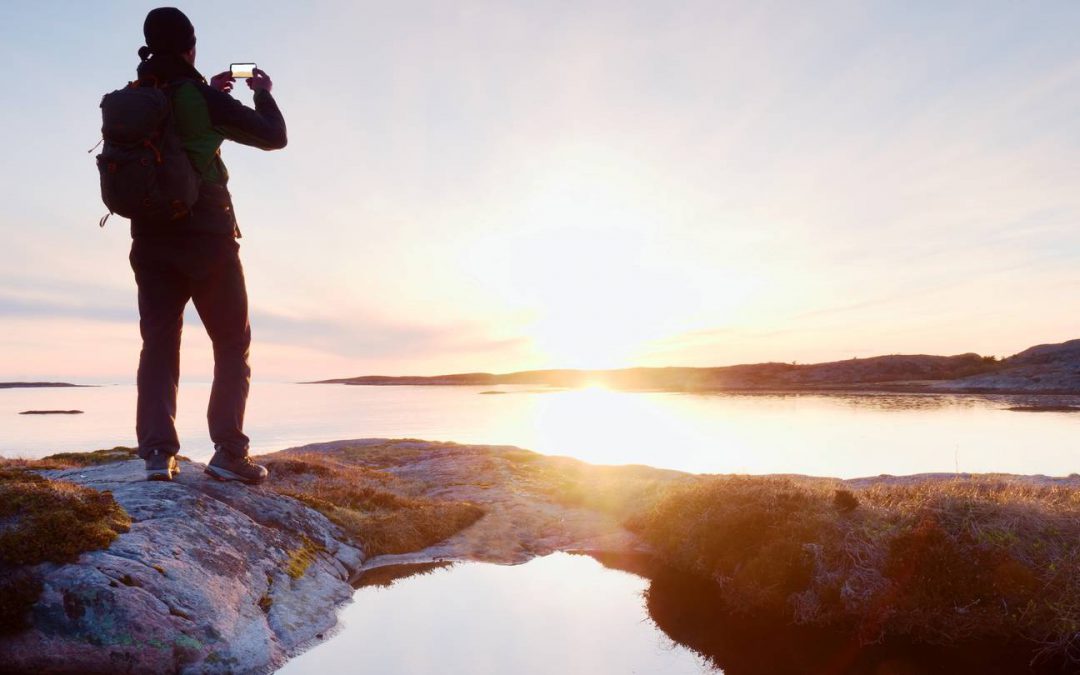Riding for good: Bruce Cotterill and Paul Muir are cycling the length of New Zealand to raise money for Men’s Mental Health and Prostate Cancer. You can follow them on Instagram @bikeforblokes and at www.bikeforblokes.co.nz
I have to admit that I’m usually fully engaged with the news cycle. And with the protesters, the Omicron outbreak and Russia’s attack on Ukraine, there’s plenty going on at the moment to keep you occupied.
However, strangely for me, despite the major implications of all three stories mentioned above, I am remarkably distant from what’s going on and quite relaxed about it.
At the time of writing, together with my mate Paul Muir, I’ve just completed day 10 of our Bike for Blokes cycle trip through the country. We’re in Masterton after what seems like a lifetime of hills, headwinds and road closures. The latter have forced an additional 100km on us so far, each time resulting in a slump in the shoulders and a couple of choice words as the realisation sets in that more time on the bike is required to get to our destination.
We’re riding with a purpose; to raise $200,000 for men’s mental health and prostate cancer. Our fundraising efforts are sitting at $98,000, almost halfway to the target. There is plenty of cycling left and a lot of fundraising yet to be done.
Of course, most of us haven’t travelled around the country that much in the past two years. The good news is that the country looks good. It’s greener than usual, even up north, because we’ve had a bit of summer rain. Farmers are making hay and the cattle look well-fed.
Riding a bike provides a unique opportunity to assess the state of the country from a different perspective. You have more time to look around. You see things you don’t see in a car. You venture from relaxed riding and enjoyment of the scenery, to fearing for your life as an 18-wheel truck and trailer unit goes past a bit too fast and a bit too close.
To be fair to the truckers, for the most part they’ve been fantastic. Through the Central Plateau they treated us well, gave us plenty of room and waved us through. A New World truck even stopped on a tight section of road and followed us for about two minutes before he felt safe to pass. Such behaviour makes for a grateful cyclist.
One thing that stands out from our first 10 days on the road is the decline of small-town New Zealand. Some towns are in bad shape as a result of long-term issues, while others are suffering the short-term impact of the Covid slump.
Two towns that stand out for all the wrong reasons are many hours apart, but with strikingly similar challenges. I refer to Kaitāia and Taumarunui. The Far North continues to suffer from decades of neglect.
Locals tell us crime and drugs are a major factor. And the collapse of tourism hasn’t helped. Despite the various attempts by central and local government alike, the problems continue. While the bright new Kaitāia Pak’nSave thrives in its location on the town’s fringe, the former Pak’nSave building in the old town centre is the saddest property in town. Sitting empty and neglected, it has become the target of those bent on graffiti and vandalism. It sits as a metaphor for a town that needs help.
Lots of shops are vacant or closed, but this one stands out and says something. Things are not good.
Other towns relied on the main trunk line for their patronage and the energy and finance that comes with people and movement. Of course, activity on the main trunk line all but dried up decades ago, and riding into towns like Te Kuiti and Taumarunui provides an eerie reminder of a bygone era. Te Kuiti has the new statue of Sir Colin Meads and the related exhibition, not to mention the best cheese scones so far, providing a small ray of sunshine in an otherwise dormant environment.
But as I rode the side streets of Taumarunui, entire avenues of buildings are vacant. Some once housed government departments, motor vehicle dealers, local newspaper publishers and signwriters. But it’s all gone. There are plenty of vacant buildings on the main street too. Some were cafes and food stores, others apparel retailers.
But when small towns lose their visitors, they lose their young people and a spiral of decline is the result.

As our tourism industry seeks to rebound from the events of the past two years there are some observations learned from spending each night in a different town for the last 11 days.
I’m sure that many of us, myself included, long for the return of our tourism industry to its once award-winning best. But time has changed things and we need to come back better than we were, just to remain competitive.
First, one of the great successes of the pandemic has been our vision to establish world-class fibre networks. And yet, our mobile and Wi-Fi services in the main tourism centres are not good enough. Sure, it’s pretty good in Queenstown, but try downloading your GoPro video in the Far North or a photo from your wife in Milford Sound and you’ll be disappointed. Simply put, our tourism infrastructure needs to be constantly upgraded if we are to remain competitive.
The industries that service tourists have understandably been relaxing for the past two years. But with the country opening up, it’s time to get out the paintbrush, put the customer service hat back on and start acting like you want people to show up. In our 12 days on the road, too many motel phones went unanswered, or worse, were answered by call centres who couldn’t help with our inquiry. Too many accommodation options are closed or partly closed. Too many restaurants continue to act as if they are doing you a favour by letting you into their eatery.
It’s time to bend over backwards and thank people for coming. We need to welcome visitors to our regions and our facilities. We need to make sure those facilities measure up and that visitors and guests feel welcome and valued.
The restaurant in Masterton did that very effectively. It’s funny how easy it is when you see great customer service done well. It makes you wonder why everyone doesn’t do it.
In the meantime, we’ll keep riding, keep fundraising and keep checking in with the country and its people. At this point we’re about halfway. I’m sure there’ll be plenty more stories.
This article first appeared in the New Zealand Herald on Saturday 5 March 2022.

Recent Comments